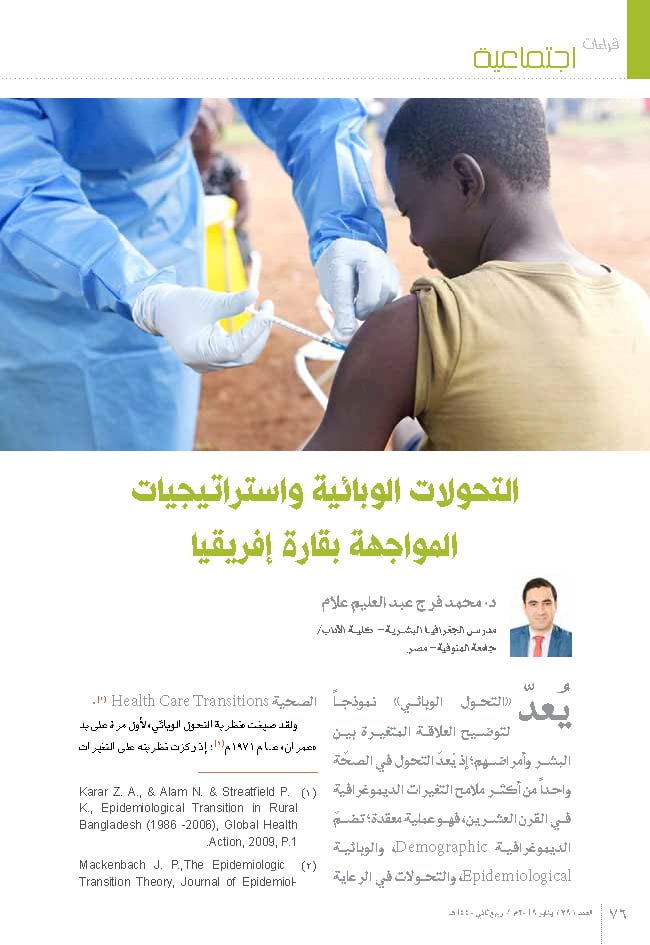Abstract: Health transition has been one of the most important features of demographic changes in the twentieth century. It is a complex process comprising demographic, epidemiological, and health care transitions that manifested in rising life expectancy at birth due to changes in the fertility, mortality, and morbidity profile of a population. The five-stage epidemiological transition cycle (epidemics and famines, epidemics, chronic diseases, emerging and emerging diseases). The population history of the continent of Africa indicates that the continent has undergone changes in health aspects because of the political, economic and social conditions it has experienced. The continent has been plagued by many epidemics since the end of the 19th century and the beginning of the 20th century (Sleep Sickness, Cholera, Plague. Sub-Saharan Africa remains the only major area in the world where the burden of infectious disease still outweighs the burden of noncommunicable disease and injuries. While the rates of decline in fertility and mortality vary considerably across the region, at least one clear pattern is emerging that holds across all of sub-Saharan Africa: a steady rise in noncommunicable disease (including cardio-metabolic and respiratory conditions as well as cancers) in the presence of significant, long-standing infectious disease prevalence. This model is strongly aligned with current discussions on Africa’s “double burden of disease” which recognize the coexistence of communicable diseases such as malaria and tuberculosis, and chronic noncommunicable diseases such as hypertension, stroke, and diabetes. At present, Ecological factors caused by alterations to the environment precipitate the spread of communicable diseases by interspersing a susceptible human population in proximity with a natural reservoir or host to which they often have had no previous exposure or immunity. Vector and host populations can also exist in equilibrium until a climate or environmental change causes an equilibrium shift resulting in emergence and spread of disease, Ex.( Ebola virus, H5N1 influenza, Coronavirus).
الملخص: يُعدّ «التحول الوبائي» نموذجاً لتوضيح العلاقة المتغيرة بين البشر وأمراضهم؛ إذ يُعدّ التحول في الصحة واحداً من أكثر ملامح التغيرات الديموغرافية في القرن العشرين، فهو عملية معقدة تضم الديموغرافية والوبائية, والتحولات في الرعاية الصحية. ولقد صيغت «نظرية التحول الوبائي» لأول مرة على يد «عمران» عام 1971م؛ إذ ركزت نظريته على التغيرات المعقدة في أنماط كلٍّ من الصحة والمرض، وعلى التفاعلات بين تلك الأنماط، والمحددات الديموغرافية والاقتصادية والاجتماعية الخاصّة بها، ونتائجها3. وفي إفريقيا مرت دورة التحول الوبائي بمراحل رئيسة، هي: مرحلة انتشار الأوبئة والمجاعات، وقد تعاقب على القارة منذ نهاية القرن التاسع عشر وبداية القرن العشرين العديد من الأوبئة، ولعل أبرزها: مرض النوم والكوليرا والطاعون. وفي مرحلة «انحسار الأوبئة»، التي تتسم عالميّاً بقلّة حدوث الأوبئة، فإنّ القارة تواجه عبئاً مرضيّاً مزدوجاً، يتمثل في الجمع بين الأمراض المعدية مثل الملاريا والسل، والأمراض المزمنة غير المعدية، مثل ارتفاع ضغط الدم والسكتة الدماغية والسكري. وتتميز مرحلة «الأمراض التناكسية» بسيادة الأمراض غير المعدية، أو ما يُطلق عليها «الأمراض المزمنة»، وهي تمثّل مشكلةً كبرى وعبئاً صحيّاً عامّاً في البلدان النامية، وتُعدّ المرحلة التالية «الأمراض المتأخرة» مرحلةً مكمّلةً للمرحلة السابقة، ولكن التقدّم الطبي ساعد في إطالة متوسط العمر المتوقع. ويترتب على الوفيات الناجمة عن الأمراض غير المعدية، تقليل الإنتاجية، وتقليص النمو الاقتصادي، ومن أبرز الأمراض غير المعدية بإفريقيا: أمراض القلب والأوعية الدموية، ضغط الدم، والسرطان، والسُّكريّ. أما مرحلة «الأمراض المنبثقة والمستجدة»؛ فتتمثل في عودة أمراض اختفت وبزوغ أمراض لم تكن معروفة من قبل، ولقد أصبحت الأمراض المنقولة بالنواقل واحدةً من المشكلات الصحية الرئيسة بالبلدان الاستوائية، ومثلاً هاجم فيروس إيبولا القاتل القارة السمراء، وبخاصة الأجزاء الغربية منها (ليبيريا، وسيراليون، وغينيا). إنّ هذا العبء المزدوج من الأمراض، المعدية وغير المعدية، يفرض أعباء اقتصادية باهظة على الاقتصاديات الفردية والوطنية على السواء في إفريقيا؛ لذا لزم وضع استراتيجيات مواجهة لتلك التغيرات، فكثير من دول العالم التي مرت بهذا التحول اتخذت إجراءات صحية ساعدتها على تجاوز تداعيات التحول، وساهمت في ارتفاع الحالة الصحية لسكانها.







































